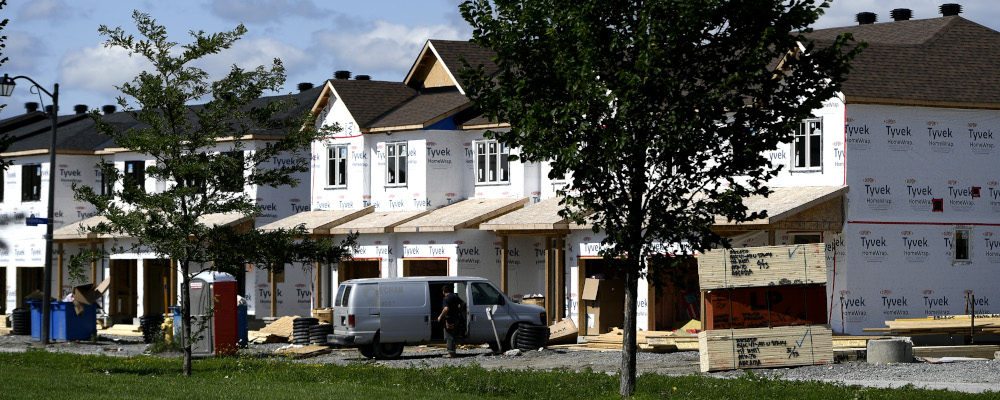As the federal election campaign reaches its final stretch, it’s increasingly clear, based on a combination of public polling and how the party leaders have allocated their own time, resources, and attention, that housing, health care, and childcare all rank near the top of the public policy agenda.
Although these three policy issues may seem quite different, they share one major commonality: they’re all cases of a persistent supply-demand gap that’s leading to shortages and in turn driving up prices or producing long wait lists.
This isn’t really supposed to happen in a market economy. Markets are supposed to act as signaling devices to transmit information between buyers and sellers in order to bring supply and demand into something approximating an equilibrium. Yet in these three policy areas — housing, health care, and childcare — the signaling device seems broken. We have more buyers than sellers and yet the market isn’t responding to increase supply to meet the demand.
The impact can be measured in terms of supply shortages, inflated prices, or broader consequences for individuals and families. Take housing for instance. A 2021 report published by Scotiabank estimated that, based on population trends, there should have been 90,000 more homes built in Canada over the past 36 months.
Or consider childcare. A pre-pandemic study by Statistics Canada found that, while most families don’t have difficulties securing childcare, about 40 percent reported challenges related to access, affordability, or compatibility with work. That number has increased slightly in the context of COVID-19.
And, of course, health-care shortages have been top-of-mind over the past several months. Not only does Canada have a poor record on medical wait times generally, but it’s bound to get much worse as the pandemic has contributed to massive backlogs for surgical procedures and diagnostic testing in what’s been described as the “crisis behind the crisis.”
The magnitude of the supply shortages in these areas is the subject of debate (it can depend, for instance, on how one defines different types of supply) but generally there isn’t much contention that these supply-demand gaps exist or that they are manifesting themselves in ways that are harmful to the economic and social well-being of Canadians.
The real debate is what policymakers ought to do about them. At the root of the competing perspectives is differing interpretations about the source of the problem. Is it a market failure or a government failure?
A common view among policy experts and politicians is that the source of the problem is the market itself. The supply-demand disequilibrium, according to this point of view, is a result of market failure. The idea here is that the market is malfunctioning for various reasons and as a result not producing adequate supply to meet demand in housing, health care, or childcare. Governments must therefore step in and solve for the persistent supply shortages in these areas.
This is the underlying basis, for instance, for the Liberal Party’s national childcare proposal. Although politicians don’t necessarily speak in these basic economic terms, the premise of the Liberal plan is that the market won’t create enough so-called “high-quality” childcare spaces on its own and that the government must intervene with a combination of public subsidies and direct public provision to fill the gap.
The problem with this assumption is that it fails to reckon with the role that government policy has played in interfering with the market’s proper functioning in the first place. Take childcare. The economist Pierre Fortin, for instance, has described how after the introduction of $10 per day daycare in Quebec, spaces in non-subsidized care (which, together with non-centre based care, still make up the majority of spaces in the province) “understandably crumbled” as a result of the province’s intervention.
The Quebec daycare case is merely one example of a series of policies enacted by Canadian governments to intervene in the functioning of the housing, health care, and childcare markets in the name of equity, safety, and even aesthetics.
Canadians may be prepared to live with fewer rules and regulations on housing, health care, and childcare if it permits the market to function better.
It’s axiomatic that these policy choices, all of which may be well-intended and even justified in and of themselves, have had the cumulative effect of interfering with the market’s ability to properly function by short-circuiting the transmission of information between buyers and sellers.
In particular, policy interventions such as stringent land-use restrictions, strict licensing requirements for childcare, and prohibitions on the use of private clinics have both muted the signaling device and blocked those who can still faintly hear it from responding by building more homes or creating more childcare spaces or carrying out more surgeries.
These are, in other words, among the most regulated parts of our economy and society and it’s no coincidence that they share a persistent supply-demand gap.
Yet, even still, it’s important to emphasize that the underlying case for these government interventions isn’t inherently wrong just because they affect availability or prices. One can reasonably agree or disagree with the arguments for these various policy choices on their own merits.
These are complicated questions after all: Should we build more homes or have more greenspace? Should we require childcare providers to be licensed or not? Should we permit more private health-care delivery or limit it to the single-payer model?
But no matter how one answers these questions, it shouldn’t be arguable that these policy choices will doubtless have effects on the market’s functioning and in turn lead to more (or less) homes, more (or less) childcare spaces, and more (or less) health-care capacity.
Just because one’s choices may lead to less supply in any of these areas still isn’t in and of itself an argument against them. It may be quite reasonable to argue that a particular policy objective (including, for instance, limiting the ratio of staff to children in a childcare setting in the name of attention and safety) ought to be paramount relative to concerns about access and affordability.
That’s the nature of politics and government in a world of trade-offs: it necessarily places certain goals above other ones and uses the levers of public policy to tilt in favour of those overriding objectives.
In order to make these decisions in an evidence-based and rigorous manner, however, policymakers must understand the inherent trade-offs and how the public thinks about them. Yet so much of the campaign debates about housing, health care, and childcare seems to neglect these trade-offs.
This matters because many of those who argued for existing interventions now want another round of policy interventions to account for the costs imposed by the previous ones. The layering of interventions on top of interventions fails to grapple with the root causes of the problem. It reflects a weird myopia where people can’t seem to see the full consequences of their policy preferences.
What’s interesting though is that polling consistently shows that housing, health care, and childcare are major areas of concerns which tells us that Canadians can indeed see them and may no longer be satisfied with these inherent trade-offs. They may be prepared to live with fewer rules and regulations on housing, health care, and childcare if it permits the market to function better and in so doing improves access and affordability.
The political parties seem to have increasingly heard this message on the housing file. The Conservatives, in particular, have committed to tie federal transit funding to provinces and municipalities liberalizing their land-use rules in order to enable more housing builds.
This is a good step. It reflects a growing recognition that the best means to addressing the country’s housing affordability challenges isn’t to tinker with demand-side supports including new tax credits or mortgage rules. It’s to free up the market to build more homes.
But the parties have been much slower to come to a similar view on health care and childcare shortages. Instead policy activists and politicians continue to assert that there’s a market failure and that’s still somehow a trump card that precludes any constructive debate about the root causes of the ongoing supply shortages in these areas and what we ought to do about them. The sole answer is invariably more spending, more intervention, and more government.
Basically, the health care and childcare policy debates are about where the housing file was five-to-ten years ago. Perhaps that’s a cause for optimism. Maybe it’s a sign that dispassion and evidence can still ultimately prevail.
It’s also possible though that both sides are correct. It’s conceivable that even in a more permissive and pluralistic policy framework that over time we could find a remaining supply-demand gap that would necessitate the types of interventions (including greater state involvement in childcare) that some are calling for in this campaign. But it’s impossible to make this judgement now given that the panoply of pre-existing interventions is obscuring our ability to see how the market would function on its own devices.
This is all to say that in the remaining days of this campaign when policy experts and politicians assert that the government needs to intervene to correct a market failure, we shouldn’t merely accept their claims. Canadians ought to push them for evidence that the real problem is a case of the market malfunctioning and not the government short-circuiting the market’s signaling device.
The root cause of the problem is usually the latter. It certainly seems the case in housing, health care, and childcare. If only our political parties could see it.
Recommended for You

Rudyard Griffiths: Mark Carney should pay attention to Canadian bonds. Trouble is brewing at the long end of the curve.

‘We are not the United States. No one needs to own Canadian bonds’: Rudyard Griffiths and Sean Speer on Canada’s looming debt crisis

DeepDive: Bridging the imagination gap: Why Canadian businesses must rethink AI adoption now

Need to Know: Canadian multiculturalism is ‘dangerously adrift’



